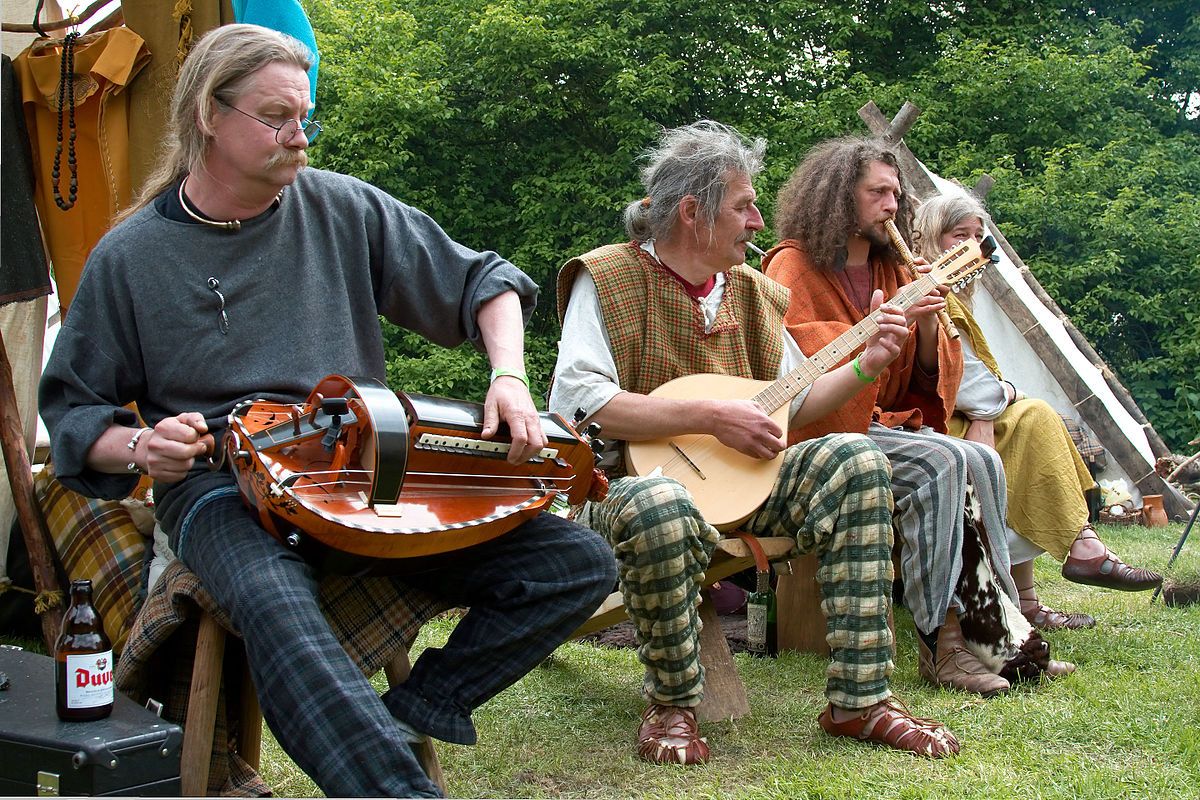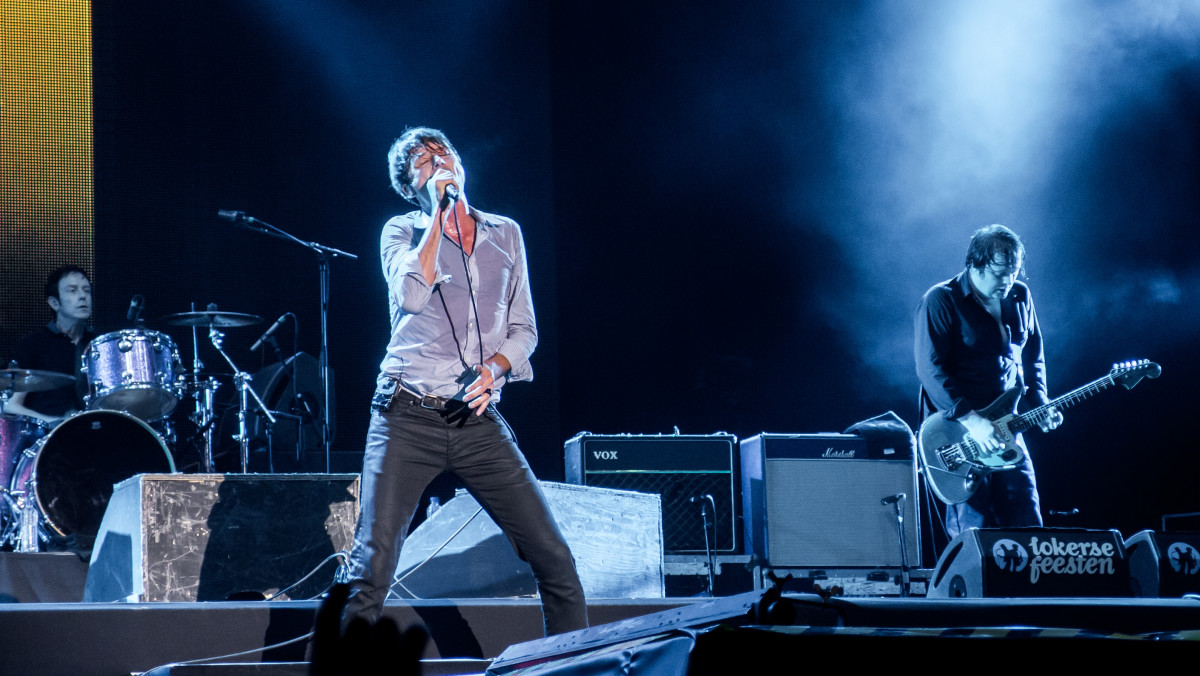Home>Production & Technology>Tempo>What Tempo Is Rock Music


Tempo
What Tempo Is Rock Music
Published: December 10, 2023
Discover the tempo of rock music and how it influences the energy and rhythm of this popular genre. Explore the unique beats and pacing that make rock music so dynamic.
(Many of the links in this article redirect to a specific reviewed product. Your purchase of these products through affiliate links helps to generate commission for AudioLover.com, at no extra cost. Learn more)
Table of Contents
- Introduction
- Definition of Tempo
- The Influence of Tempo in Music
- Tempo Variations in Rock Music
- Common Tempos in Rock Music
- The Relationship Between Tempo and Energy in Rock Music
- The Impact of Tempo on the Overall Feel and Style of Rock Music
- Tempo Changes and Their Effect on the Listener’s Experience
- Conclusion
Introduction
Rock music has been a dominant genre for decades, captivating music lovers with its raw energy, powerful vocals, and hard-hitting instrumentals. But there’s another element that plays a crucial role in shaping the distinctive sound of rock music: tempo. Tempo refers to the speed or pace at which a piece of music is played, and it has a profound impact on the overall feel and style of a song.
In this article, we delve into the world of tempo in rock music, exploring its definition, its influence on the genre, and how it affects the listener’s experience. From fast and frenetic punk rock to slow and heavy metal, tempo is a key factor in shaping the sonic landscape of rock music.
Understanding the intricacies of tempo in rock music not only allows us to appreciate the artistry of musicians and songwriters, but also provides valuable insights for aspiring musicians, producers, and music enthusiasts who want to delve deeper into the genre.
So, let’s dig in and uncover the fascinating role that tempo plays in the realm of rock music.
Definition of Tempo
Tempo, in the context of music, refers to the speed at which a piece of music is played. It can be thought of as the heartbeat or pulse of a song. The tempo is usually measured in beats per minute (BPM), which indicates the number of beats or pulses that occur within one minute of the music.
Tempo plays a crucial role in conveying the mood, energy, and overall feel of a song. A fast tempo creates a sense of urgency, excitement, and liveliness, while a slow tempo generates a more relaxed, introspective, or melancholic atmosphere. Different tempos can evoke varied emotions and elicit different responses from the listener.
In musical notation, tempo is typically indicated with Italian terms, which provide a general guideline for the speed of the music. Some common tempo markings include:
- Adagio – slow and leisurely
- Andante – moderately slow and flowing
- Moderato – moderate tempo
- Allegro – fast and lively
- Presto – very fast and rapid
These tempo markings provide a starting point for musicians, but the actual tempo may vary depending on the style of the piece and the interpretation of the performer.
Tempo is not only a fundamental aspect of music theory, but it also serves as a crucial foundation for musicians to maintain synchronization and cohesion within an ensemble. It allows musicians to communicate and navigate through the music effectively, ensuring that all performers are on the same rhythmic page.
In the realm of rock music, tempo is particularly significant due to its close connection to the genre’s inherent energy and intensity. The tempo of a rock song can dictate the pace of the instrumentation, the delivery of vocals, and the overall sense of dynamism and power. Understanding and harnessing tempo effectively is paramount for musicians looking to make an impact in rock music.
The Influence of Tempo in Music
Tempo is a fundamental element that influences the overall character and impact of a piece of music. It sets the stage for the emotions, energy, and atmosphere that the music conveys to the listener. The choice of tempo can completely transform the interpretation and reception of a song.
The tempo of a song can communicate a wide range of emotions. A fast tempo often signifies excitement, exhilaration, or urgency, while a slow tempo can evoke a sense of calm, contemplation, or sadness. The speed at which the music flows can create anticipation, tension, or relaxation, depending on the context.
Moreover, tempo is closely tied to the rhythmic structure of a composition. It defines the spacing and timing of the notes and rests, providing a framework for the musicians to synchronize their performance. A well-executed tempo establishes a cohesive and unified sound, ensuring that all elements of the music work in harmony.
Tempo also has a significant impact on the physical and physiological response of the listener. Research has shown that faster tempos can increase heart rate and adrenaline levels, leading to heightened excitement and a sense of energy. On the other hand, slower tempos can induce a more relaxed state, allowing for introspection and deeper emotional engagement with the music.
In the context of rock music, tempo plays a critical role in defining the genre’s signature intensity and power. The energetic and driving rhythms of rock music are often achieved through faster tempos, which contribute to the high-energy performance and head-banging experience that fans of the genre love. These faster tempos create a sense of adrenaline and urgency, reflecting the rebellious and edgy nature of rock music.
However, tempo variations within a song can also provide dynamic contrast and add depth to the music. A well-placed tempo change can create anticipation, surprise, or even a cathartic release for the listener. It can be used strategically to build tension, highlight specific sections, or introduce new musical ideas.
Overall, tempo serves as a powerful tool for musicians and composers to shape the emotional and aesthetic impact of their music. Whether it’s the driving force behind a high-octane rock anthem or the gentle cadence of a heartfelt ballad, tempo has the ability to guide and captivate listeners, making it an essential element in the artistry of music.
Tempo Variations in Rock Music
Rock music is known for its versatility and ability to seamlessly blend various sub-genres and styles. One aspect that contributes to this diversity is the wide range of tempo variations found within rock music. From lightning-fast punk rock riffs to slow and heavy metal ballads, tempo variations play a crucial role in defining the unique sound and character of different rock songs.
One common tempo variation in rock music is the use of accelerando and ritardando. Accelerando refers to a gradual increase in tempo, while ritardando refers to a gradual decrease. These variations can add excitement and build tension within a song, creating a dynamic listening experience. For example, in a rock song, a gradual accelerando may signal the approaching climax or a burst of energy, while a ritardando can provide a moment of respite or a reflective interlude.
Another tempo variation technique commonly used in rock music is the use of double-time or half-time. Double-time involves playing the notes at twice the speed of the original tempo, while half-time slows down the tempo to half its original speed. These variations can dramatically change the feel and intensity of a song. By increasing the tempo to double-time, a rock song can take on a frantic and frenzied quality, adding an extra layer of intensity. On the other hand, halving the tempo to half-time can create a heavy and weighty atmosphere, accentuating the powerful and sludgy nature of certain rock sub-genres like doom metal.
Additionally, rock music often incorporates tempo variations within individual sections of a song. This allows for dynamic shifts and contrasting moods. For example, a rock song may feature fast-paced verses with driving rhythms and high-energy performances, contrasting with a slower and more melodic chorus. These tempo variations help create interest and keep the listener engaged throughout the song, allowing for moments of tension and release.
Tempo variations in rock music are not limited to a single sub-genre or style. Different rock sub-genres have their own unique approach to playing with tempo. Punk rock, known for its fast and aggressive sound, maintains intense and consistent tempos throughout, rarely deviating from its energetic pace. In contrast, progressive rock often embraces complex and intricate arrangements, incorporating frequent tempo changes to create a captivating musical journey.
By utilizing tempo variations, rock musicians can achieve a diverse range of sonic experiences within their songs. These variations allow for the exploration of different emotions, intensities, and moods, adding depth and complexity to the overall musical composition. Furthermore, they showcase the inventiveness and artistic freedom that rock music offers, making it an exciting genre to both create and listen to.
Common Tempos in Rock Music
Rock music encompasses a wide range of sub-genres, each with its own distinct style and sound. As a result, there is a diverse range of tempos found within the realm of rock music. From lightning-fast punk rock to slow and heavy metal, the tempo of a rock song greatly contributes to its overall character and impact.
One of the most common tempos in rock music is the up-tempo, which generally falls within the range of 120 to 160 beats per minute (BPM). This tempo range is commonly associated with high-energy sub-genres like punk rock, pop punk, and alternative rock. Up-tempo rock songs create an exhilarating and energetic atmosphere, fueled by fast-paced guitar riffs, driving drum beats, and rapid-fire vocals. The intensity of these tempos often fuels energetic live performances and encourages crowd participation.
On the other end of the spectrum, rock music also embraces slower tempos that emphasize heavy, pounding rhythms. In sub-genres like doom metal and stoner rock, tempos can range from 60 to 90 BPM or even slower. Slower tempos allow for a more deliberate and weighty sound, creating a sense of power and intensity. These slower rock songs often feature thick, distorted guitar tones and dense, atmospheric arrangements that immerse the listener in a sonic experience.
Another common tempo in rock music is the medium tempo, typically ranging from 80 to 120 BPM. Medium-tempo rock songs exhibit a balanced and versatile feel. They provide a steady groove and allow for various stylistic elements to flourish. Many classic rock hits, as well as sub-genres like hard rock and blues rock, fall within this tempo range. The versatility of medium tempos caters to a wide audience, delivering a sound that is both accessible and engaging.
It’s worth noting that rock music also explores tempo variations within individual songs. For example, a rock ballad might start slowly and contemplatively, gradually building up the tempo and intensity to create a powerful climax. These tempo changes add depth and complexity to the song, enhancing the emotional impact and keeping the listener engaged.
Ultimately, the choice of tempo in rock music is driven by the desired emotional and stylistic effect that the artist or band aims to achieve. Whether it’s the high-powered energy of up-tempo punk rock or the crushing weight of slow-tempo metal, the tempo selections in rock music contribute to the genre’s diverse and evolving landscape.
The Relationship Between Tempo and Energy in Rock Music
Tempo plays a critical role in determining the energy and intensity of rock music. The choice of tempo heavily influences how a song is perceived, and it directly impacts the level of energy and excitement that the music conveys to the listener.
In general, higher tempos in rock music are associated with increased energy. Fast-paced songs with rapid tempos like those found in punk rock, hardcore, and thrash metal create a sense of urgency and adrenaline. The driving rhythms and aggressive instrumentation propel the music forward, fueling the intense energy that rock fans crave. These high-tempo rock songs often evoke feelings of exhilaration and power, and they are often the soundtrack to high-energy live performances and mosh pits.
On the other hand, slower tempos in rock music can generate a different kind of energy. While the pace is more deliberate, slow-tempo rock songs can be just as powerful and captivating. The heavy and methodical nature of genres like doom metal and sludge rock rely on slower tempos to create a crushing and immersive sonic experience. The weight and intensity of slower tempos allow for a deep emotional connection with the music, evoking a sense of tension and anticipation.
It’s important to note that energy in rock music isn’t solely determined by tempo. While tempo sets the overall pace and can influence the energy level, other musical elements such as instrumentation, arrangement, and performance also contribute significantly. For example, a fast-tempo song with softer dynamics and melodic instrumentation may convey a different energy than a fast-tempo song with aggressive, distorted guitar riffs and pounding drums.
Moreover, the energy of rock music can be further shaped by tempo variations within a song. By incorporating strategic tempo changes, rock musicians can create dynamic contrasts that add depth and excitement to the music. A sudden increase in tempo after a slower section can inject a surge of energy, while a sudden drop in tempo can create a moment of suspense or introspection.
The relationship between tempo and energy in rock music is multi-dimensional and dynamic. It is a careful balancing act between the desired emotional impact, the collective musical performance, and the genre’s conventions and expectations. Ultimately, whether it’s the exhilarating fast-paced bangers or the slow-burning epics, rock music relies on tempo as a powerful tool to channel and express its unique energy and intensity.
The Impact of Tempo on the Overall Feel and Style of Rock Music
The tempo of a rock song is a crucial element that influences the overall feel and style of the music. Whether it’s a fast, frenetic punk rock anthem or a slow, brooding metal ballad, tempo plays a significant role in shaping the sonic landscape and emotional impact of rock music.
First and foremost, tempo sets the pace and establishes the rhythmic foundation of a rock song. A fast tempo creates a sense of urgency, energy, and excitement, propelling the music forward with a relentless drive. This fast-paced movement is often associated with the high-energy, rebellious spirit of rock music, particularly genres like punk rock, hardcore, and fast-paced metal sub-genres. The faster tempo lends itself to aggressive guitar riffs, rapid drumming, and intense vocal performances, adding to the bold and energetic nature of these sub-genres.
In contrast, slower tempos in rock music evoke a different mood and style. They allow for a more deliberate and methodical approach, creating a sense of weight, depth, and introspection. Slower tempos often feature heavy, distorted guitar tones, pounding drums, and powerful vocals. Genres like doom metal, sludge rock, and certain rock ballads embrace these slower tempos to maximize impact and emotional intensity. The deliberate pacing and extended note durations in these slower songs create an immersive and atmospheric experience, showcasing the artistry and depth of the music.
Furthermore, the choice of tempo can contribute to the stylistic classification of rock music. Different sub-genres and styles have their own distinctive tempo preferences, which not only shape the feel of the music but also define the genre itself. For example, punk rock is typically characterized by fast and aggressive tempos, creating an edgy and rebellious sound. In contrast, blues rock often employs medium tempos, infusing a sense of groove and swagger into the music. These tempo choices help differentiate and define the various sub-genres within the broader rock genre.
Additionally, tempo can influence the song structure and arrangement in rock music. It determines the length of musical phrases, the spacing of chord progressions, and the timing of instrumental solos or vocal hooks. Different tempos provide opportunities for variation and experimentation within the structure of a song. For instance, fast tempos lend themselves to shorter and more intense bursts of energy, while slower tempos allow for extended and atmospheric musical passages.
Overall, tempo is a fundamental component that shapes the overall feel and style of rock music. It guides the energy, mood, and pacing of the music, providing a framework for the expression, creativity, and dynamics within the genre. The skilled manipulation of tempo allows rock musicians to create diverse and captivating sonic experiences, showcasing the vast possibilities and versatility of this beloved genre.
Tempo Changes and Their Effect on the Listener’s Experience
Tempo changes within a rock song can have a profound impact on the listener’s experience, adding depth, tension, and excitement to the music. These shifts in tempo create a dynamic and multisensory journey, enhancing the emotional impact of the song and capturing the listener’s attention.
One of the key effects of tempo changes is the element of surprise. When a song transitions from one tempo to another, it can catch the listener off guard and create a sense of anticipation. An abrupt shift to a faster tempo can inject a surge of energy, invoking a visceral response and potentially inspiring movement or dancing. Conversely, a sudden slowdown to a slower tempo can create a moment of respite or reflection, allowing the listener to catch their breath and absorb the emotional weight of the lyrics or instrumentation.
Tempo changes also contribute to the overall pacing of a song. By strategically altering the tempo at certain points, musicians can control the ebb and flow of the music, guiding the listener through various emotional peaks and valleys. For example, a rock ballad might start with a slow and melancholic tempo, building up gradually to a faster tempo for the chorus or climax of the song. This journey from soft to loud, slow to fast can create a heightened sense of drama and catharsis, amplifying the emotional impact and creating a memorable listening experience.
Moreover, tempo changes can serve as a means of emphasizing or highlighting specific sections of a song. For instance, a bridge section might feature a distinct tempo change to signify a departure from the main verses and choruses. This tempo variation can help to differentiate and elevate the bridge, making it stand out and capturing the listener’s attention. By creating contrast through tempo changes, musicians can introduce variation and enhance the overall compositional structure of the song.
Tempo changes also allow for creative expression and experimentation within the genre of rock music. Musicians and bands can play with different tempo combinations to create unique and unexpected moments. For example, a song might start with a slow tempo, gradually build up to a fast tempo, and then return to a slower tempo for the ending. These unpredictable shifts keep the listener engaged and continually surprised, showcasing the artist’s versatility and pushing the boundaries of traditional song structures.
Overall, tempo changes in rock music serve as a powerful tool to captivate and engage the listener’s emotions. By crafting carefully timed shifts in tempo, musicians can create tension, release, and a sense of movement within the music. These well-executed tempo changes heighten the listener’s experience, drawing them into the song and leaving a lasting impression.
Conclusion
Tempo is an essential element in rock music, shaping the overall feel, energy, and style of the genre. Whether it’s the fast and furious punk rock anthems or the slow and heavy metal ballads, tempo plays a crucial role in defining the sonic landscape and emotional impact of rock music.
From the driving beats and rapid guitar riffs of up-tempo rock songs to the deliberate pacing and weighty riffs of slower tempos, the choice of tempo has a profound effect on the listener’s experience. It sets the mood, dictates the energy level, and contributes to the overall character of a song. Through tempo variations, rock musicians can create dynamic contrasts, heightening the emotional impact and keeping the listener engaged throughout the journey.
Tempo in rock music is not simply a matter of speed; it’s a powerful tool for expression and creativity. It enables musicians to establish a rhythmic foundation, communicate emotions, and guide the listener through a diverse range of sonic experiences. The deliberate selection of tempo, along with other musical elements, allows rock musicians to craft unique compositions and connect with audiences on a deep and visceral level.
Understanding and harnessing the power of tempo in rock music is not only essential for musicians and composers but also for music enthusiasts who appreciate the artistry and complexity of the genre. By recognizing the impact of tempo on the overall feel and style of rock music, listeners can develop a greater appreciation for the intricacies of the compositions and the emotions they evoke.
In conclusion, tempo is a fundamental building block of rock music, shaping its energy, mood, and identity. It provides the heartbeat, the pulse, and the foundation upon which the genre thrives. From fast and frenetic to slow and heavy, tempo is a powerful force that drives the music and captivates the listener’s soul. So, the next time you listen to your favorite rock song, pay attention to the tempo and allow it to transport you into the electrifying world of rock music.











